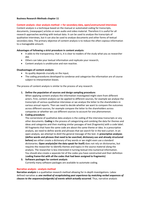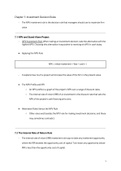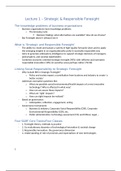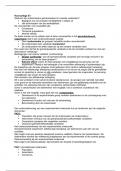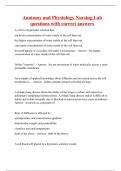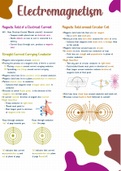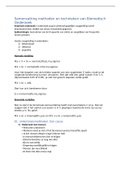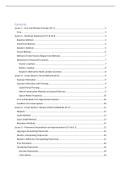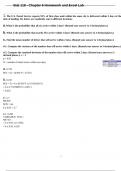Business Research Methods chapter 11
Content analysis: clear analysis method -> for secondary data, open/unstructured interviews
Content analysis is a technique based on the manual or automated coding for transcripts,
documents, (newspaper) articles or even audio and video material. Therefore it is useful for all
research approaches working with textual data. It can be used to analyse the transcripts of
qualitative interviews, but it can also be used to analyse documents and other forms of textual
secondary data. The primary objective of content analysis is to reduce the often copious information
to a manageable amount.
Advantages of following a strict procedure in content analysis:
It adds to the transparency; that is, it is clear to readers of the study what you as researcher
did;
Others can take your textual information and replicate your research;
Content analysis is unobtrusive and non-reactive.
Disadvantages of content analysis:
Its quality depends crucially on the input;
The coding procedures developed to condense and categorize the information are of course
subject to interpretation biases.
The process of content analysis is similar to the process of any research:
1. Define the population of sources and design sampling procedure:
When applying content analysis the information investigated might stem from different
actors. First, content analysis can be applied to different sources, for example we analyse the
transcripts of various qualitative interviews or we analyse the letter to the shareholders in
various annual reports. Then we need to decide whether we want to compare the outcomes
across different sources, for example compare the letter to the shareholders across
companies or whether we use different sources to account for one phenomenon.
2. Coding procedure:
The cornerstone of qualitative data analysis is the coding of the interview transcripts or any
other documents. Coding is the process of categorizing and combing the data for themes and
ideas and categories and then marking similar passages of text (fragments) with a code label.
All fragments that have the same code are about the same theme or idea. In a prescriptive
analysis, we need to define words and phrases that we search for in the text a priori. In an
open analysis, we attempt to distil the general message of the text. In prescriptive analyses
(define words and phrases that need to be searched, dictionary use and already structured
before) we either create a dictionary of key words or we might even use a standard
dictionaries. Open analysis(let the data speak for itself) does not rely on dictionaries, but
requires the researcher to identify themes and topics in the source material along the
analysis. The researcher is less interested in turning textual into numerical information.
You should also create a separate list of the codes you have constructed and their definition
(coding frame=list with all the codes that had been assigned to fragments)
3. Software packages for content analysis
Currently many software packages are available to automate coding.
Narrative analysis : analysis method
Narrative analysis is a qualitative research method allowing for in-depth investigations. Labov
defined narrative as one method of recapitulating past experience by matching verbal sequences of
clauses to the sequences(volgorde) of events which actually occurred. Thus, narrative analysis
Content analysis: clear analysis method -> for secondary data, open/unstructured interviews
Content analysis is a technique based on the manual or automated coding for transcripts,
documents, (newspaper) articles or even audio and video material. Therefore it is useful for all
research approaches working with textual data. It can be used to analyse the transcripts of
qualitative interviews, but it can also be used to analyse documents and other forms of textual
secondary data. The primary objective of content analysis is to reduce the often copious information
to a manageable amount.
Advantages of following a strict procedure in content analysis:
It adds to the transparency; that is, it is clear to readers of the study what you as researcher
did;
Others can take your textual information and replicate your research;
Content analysis is unobtrusive and non-reactive.
Disadvantages of content analysis:
Its quality depends crucially on the input;
The coding procedures developed to condense and categorize the information are of course
subject to interpretation biases.
The process of content analysis is similar to the process of any research:
1. Define the population of sources and design sampling procedure:
When applying content analysis the information investigated might stem from different
actors. First, content analysis can be applied to different sources, for example we analyse the
transcripts of various qualitative interviews or we analyse the letter to the shareholders in
various annual reports. Then we need to decide whether we want to compare the outcomes
across different sources, for example compare the letter to the shareholders across
companies or whether we use different sources to account for one phenomenon.
2. Coding procedure:
The cornerstone of qualitative data analysis is the coding of the interview transcripts or any
other documents. Coding is the process of categorizing and combing the data for themes and
ideas and categories and then marking similar passages of text (fragments) with a code label.
All fragments that have the same code are about the same theme or idea. In a prescriptive
analysis, we need to define words and phrases that we search for in the text a priori. In an
open analysis, we attempt to distil the general message of the text. In prescriptive analyses
(define words and phrases that need to be searched, dictionary use and already structured
before) we either create a dictionary of key words or we might even use a standard
dictionaries. Open analysis(let the data speak for itself) does not rely on dictionaries, but
requires the researcher to identify themes and topics in the source material along the
analysis. The researcher is less interested in turning textual into numerical information.
You should also create a separate list of the codes you have constructed and their definition
(coding frame=list with all the codes that had been assigned to fragments)
3. Software packages for content analysis
Currently many software packages are available to automate coding.
Narrative analysis : analysis method
Narrative analysis is a qualitative research method allowing for in-depth investigations. Labov
defined narrative as one method of recapitulating past experience by matching verbal sequences of
clauses to the sequences(volgorde) of events which actually occurred. Thus, narrative analysis


